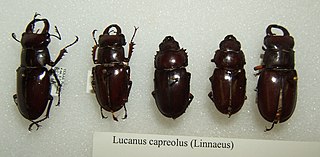
Stag beetles are a family of about 1,200 species of beetles in the family Lucanidae, currently classified in four subfamilies. Some species grow to over 12 centimetres, but most to about 5 cm (2 in).

Scarabaeoidea is a superfamily of beetles, the only subgroup of the infraorder Scarabaeiformia. Around 35,000 species are placed in this superfamily and some 200 new species are described each year. Its constituent families are also undergoing revision presently, and the family list below is only preliminary. This superfamily includes some of the largest beetles extant today, including rhinoceros beetles, (Dynastinae), the Hercules beetle and Goliath beetles.

The Lucaninae comprise the largest subfamily of the stag beetles (Lucanidae).

Lucanus cervus, known as the European stag beetle, or the greater stag beetle, is one of the best-known species of stag beetle in Western Europe, and is the eponymous example of the genus. L. cervus is listed as Near Threatened by the IUCN Red List.

Lucanus is a genus of stag beetles (Lucanidae).

Lucanus capreolus, the reddish-brown stag beetle or pinching beetle, is a beetle of the family Lucanidae. The specific name capreolus is derived from Latin, meaning "roe deer". The name refers to the resemblance of the mandibles to deer antlers.

Lucanus elaphus, the giant stag beetle or elephant stag beetle, is a beetle of the family Lucanidae native to eastern North America. They are sometimes kept as pets.

Lucanus formosanus is a stag beetle which is endemic to Taiwan, and grows to a length of 45–80 millimetres (1.8–3.1 in). Like other species in the Lucanid family, L. formosanus exhibits distinct sexual dimorphism and subsequent external morphological allometry in males. Males of the species develop mandibles of various forms depending on geographic location; i.e. northern, central, and southern morphs.

Lucanus mazama is a beetle of the family Lucanidae. Its common name is the cottonwood stag beetle. It is considered "scaraboid" but is not necessarily confined to deserts. They are often found in the wood chip ground covering at playgrounds. It is located primarily in the western and southwestern United States.

Lucanus tetraodon is a stag beetle of the family Lucanidae.
Frederic John Sidney Parry was an English entomologist who specialised in Coleoptera, principally Lucanidae.
The Lucanidae are a family of beetles that include the stag beetles. The family can be further subdivided in a taxonomy. The classification presented here follows Smith (2006), with the exception of the tribal classification within the Lucaninae.
Dorcus tenuihirsutus is a beetle species of the family Lucanidae described from Korea in 2010 by Sang Il Kim and Jin-Ill Kim.

Cyclommatus is a genus of the family Lucanidae, also known as the stag beetle. The majority of the species from the genus Cyclommatus are located in Southeast Asia, though some species are found in China and Taiwan as well. The genus Cyclommatus also consists of three subgenera: Cyclommatus, Cyclommatinus and Cyclommatellus. Each subgenera contains 80, 24 and 3 species respectively. In total, the genus Cyclommatus consists of a total of 134 species, though more are still being discovered to this day.

Lucanus laminifer is a species of beetles of the family Lucanidae.

Paralissotes reticulatus, also called the New Zealand reticulate stag beetle, is a native species of stag beetle from New Zealand. Although they do have wings they are flightless.

Dorcus parallelus, more commonly known as the antelope stag beetle, is a species from the Lucanidae family. Extensive research has not been done on this species. D. parallelus has been seen to be endemic to North America. Features of this species include its impressive size and distinctive antler-like mandibles useful during mating. These beetles are often compared to Dorcus parallelipipedus, the sister species mainly concentrated in Europe.

Dorcus rectus, the little stag beetle, is a species of beetles in the family Lucanidae. It can be found in China(Liaoning), Korea, Japan, Taiwan and Russia. These beetles have a distinctive red shell that separates them from Dorcus curvidens. Males of this species have been observed to have mandible trimorphism, a characteristic that has only been described in two species of Lucanidae—with the other one being Odontolabis cuvera—"and a small number of other invertebrates" as of 2017. The mandibles are used by males as weapons.
Lucanus datunensis is a species of stag beetle endemic to Tatun Mountain of Taiwan's Yangmingshan.It is first discovered in 1984. It is the smallest stag beetle in Taiwan and is an endangered species threatened by recent human activity.

Dorcus hopei is a beetle in the family Lucanidae.

















